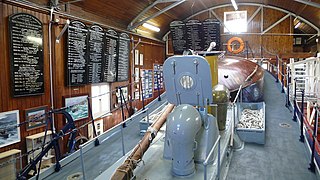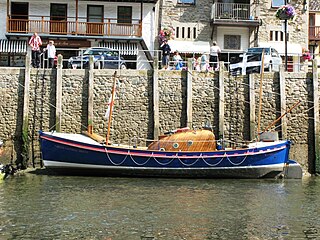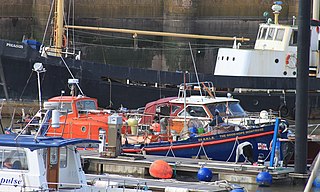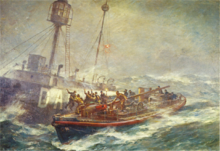
RNLB Thomas McCunn is a 45ft 6in Watson-class lifeboat stationed at Longhope in Orkney, Scotland, from January 1933 until April 1962. During which time she was launched on service 101 times and saved 308 lives. After Thomas McCunn left Longhope she was placed into the reserve fleet for ten years before being sold and used as a pleasure boat. In 2000 she was bought by Longhope Lifeboat Museum. The lifeboat is now at the centre of a display in the old slipway at Brims and is still launched on special occasions.

The Tyne-class lifeboat was a class of lifeboat that served as a part of the Royal National Lifeboat Institution fleet until 2019. They were named after the River Tyne in North East England.

RNLB H F Bailey was the first Royal National Lifeboat Institution (RNLI) lifeboat powered by a motor, that served from Cromer Lifeboat Station.

The Oakley-class lifeboat refers to two types of self-righting lifeboat operated by the Royal National Lifeboat Institution (RNLI) around the coast of the United Kingdom and Ireland between 1958 and 1993. The 37-foot (11.3 m) Oakley was designed for carriage launching, while the larger 48-foot-6-inch (14.8 m) version was designed for slipway launching or to lie afloat. During their service they saved a combined total of 1,456 lives in 3,734 rescue launches.

RNLB William and Kate Johnston is a Barnett-class lifeboat that was stationed at New Brighton in the English county of Cheshire from the summer of 1923 until 1950. The lifeboat was designed as a prototype by James R. Barnett who was a consulting naval architect to the Royal National Lifeboat Institution. She was the first Barnett-class lifeboat and at the time of her launch, she was the largest lifeboat in the world.

The Liverpool-class motorised lifeboat was a non-self-righting boat operated by the Royal National Lifeboat Institution (RNLI) from its stations around the coast of the United Kingdom and Ireland. The boats were designed for carriage launching and were developed from the Liverpool-Class Pulling and Sailing type of lifeboats - there were two types built, single and twin engined.

Norfolk and Suffolk-class lifeboats were lifeboats operated by the Royal National Lifeboat Institution (RNLI) from stations around the coasts of the United Kingdom and Ireland. They were able to operate further from shore and around the sandbanks common off East Anglia.

RNLB Abdy Beauclerk was a 41ft 'Aldeburgh' Type Beach Motor which was stationed in the town of Aldeburgh in the English county of Suffolk. She was on the No: 1 station at Aldeburgh from 1931 until she was sold out of the RNLI fleet in 1959, a total of 28 years service.

The Rother-class lifeboat was a self-righting lifeboat operated by the Royal National Lifeboat Institution around the coast of the United Kingdom and Ireland between 1972 and 1995. They were based on the 37 ft (11 m) Oakley-class lifeboat.

The term Watson-class lifeboat refers to several wooden lifeboat classes operated by the Royal National Lifeboat Institution (RNLI) around the coasts of the United Kingdom and Ireland between 1888 and 1991. The boats had hulls that conformed to the basic design laid down by RNLI naval architect George Lennox Watson.
The 47 ft Watson-class was a class of non self-righting displacement hull lifeboat built from 1955 to 1963 and operated by the Royal National Lifeboat Institution between 1956 and 1991.

The 42ft Watson-class was a class of non self-righting displacement hull lifeboat built between 1954 and 1962 and operated by the Royal National Lifeboat Institution (RNLI) around the coasts of the United Kingdom and Ireland between 1954 and 1987.
The Ramsgate-class motor lifeboat was a special design produced by the RNLI for three stations covering the Thames estuary and required to operate in shallow waters.

The 46 ft 9in Watson-class lifeboat was a non self-righting displacement hull lifeboat built between 1947 and 1956 and operated by the Royal National Lifeboat Institution between 1947 and 1989.
The Surf-class was a light non self-righting displacement hull motor lifeboat built between 1935 and 1940 and operated by the Royal National Lifeboat Institution (RNLI) between 1936 and 1965.

The 46 ft Watson-class was a non self-righting displacement hull lifeboat built between 1935 and 1946 and operated by the Royal National Lifeboat Institution between 1935 and 1981.

The 41 ft Watson-class was a non self-righting displacement hull lifeboat built between 1931 and 1952 and operated by the Royal National Lifeboat Institution between 1931 and 1981.
The 45ft 6in Watson-class was a non self-righting displacement hull lifeboat built between 1926 and 1933 and operated by the Royal National Lifeboat Institution between 1926 and 1972.
The 35ft 6in Self-righting motor-class was a 10.8 m displacement hull lifeboat built in single engine form between 1929 and 1940 and in twin-engined form between 1947 and 1950. The boats were operated by the Royal National Lifeboat Institution between 1929 and 1965.
The 45 ft Watson-class was a non self-righting displacement hull lifeboat built between 1919 and 1925 and operated by the Royal National Lifeboat Institution between 1919 and 1956.














